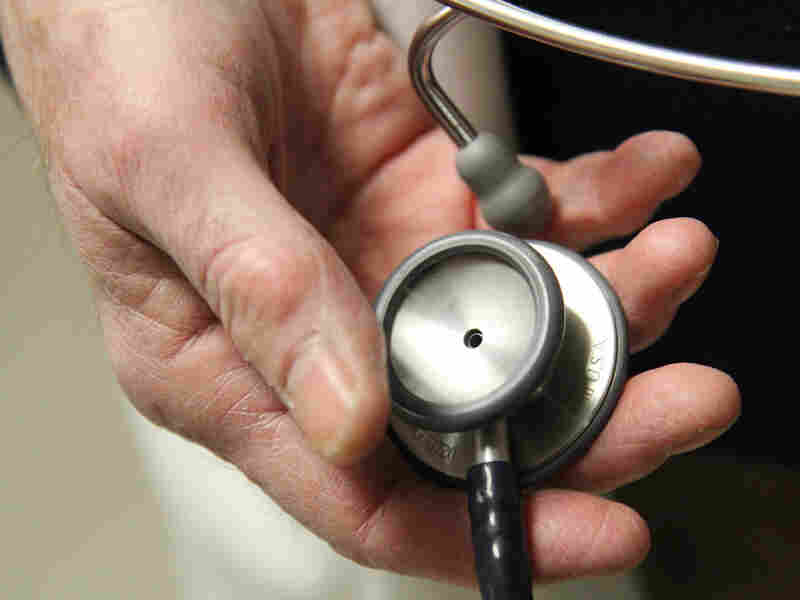Florida Doctor Says False Diagnoses Inflate Bills, Could Harm Patients
A federal whistleblower suit unsealed in late February alleges that Humana knew about billing fraud involving Medicare Advantage patients and didn’t stop it. Ty Wright/Bloomberg via Getty Images hide caption
toggle caption Ty Wright/Bloomberg via Getty Images
Insurance giant Humana Inc., which operates some of the nation’s largest private Medicare health plans, knew for years of billing fraud at some South Florida clinics but did little to curb the practice even though it could harm patients, a doctor alleges in a newly unsealed whistleblower lawsuit.
The suit was filed by South Florida physician Mario M. Baez. It accuses Humana and Baez’s former business partner, Dr. Isaac K. Thompson, of engaging in a lucrative billing fraud scheme that lasted for years. The suit also names three other Palm Beach County doctors, two medical clinics and a doctors’ practice group as defendants. The suit was filed in October 2012 but remained under a federal court seal until Feb. 26.
Humana had no comment. “As a matter of long-standing company policy, Humana does not comment on pending litigation,” said company spokesman Tom Noland.
Thompson, a Delray Beach doctor, was indicted early last year on health care fraud charges stemming from similar allegations. He had pleaded not guilty but last week indicated he would change his plea and was to appear Friday in federal court in Fort Lauderdale, according to court records.
The Baez case is likely to bring fresh scrutiny to the giant Louisville, Ky.-based insurer, which covers more than 3 million elderly patients in its Medicare Advantage plans nationwide. The case could also spotlight costly flaws in the government’s complex and controversial method for paying private Medicare health plans.
The Baez suit targets a billing formula called a risk score, which is designed to pay Medicare health plans higher rates for sicker patients and less for people in good health. But overspending tied to inflated risk scores has cost taxpayers tens of billions of dollars in recent years, as the Center for Public Integrity reported in a series of articles published in 2014.
Federal officials have struggled for years to stamp out these overcharges, known in health care circles as “upcoding,” while at least a half-dozen whistleblowers have filed lawsuits accusing Medicare Advantage plans of ripping off the government.
Baez’s case adds a new wrinkle because it alleges that inflating risks scores not only wastes taxpayer dollars but can also cause a patient to be harmed by improper medical treatment.
Baez said in a letter to the presiding judge in the case, U.S. District Judge Kenneth A. Marra, that treating elderly patients with “multiple ailments” is difficult when you have accurate data, but “when medical records are poisoned with misleading data [from inflated risk scores] it becomes Russian roulette.” Patients aren’t told their risk score and aren’t likely to know if a doctor has exaggerated how sick they are or added bogus medical conditions to their medical records to boost profits, Baez said.
Baez and Thompson were partners in two clinics in Humana’s network, Lake Worth Medical P.A. and IM Medical P.A., in Delray Beach, from 2003 to 2012. Baez alleges in his suit that in February 2009 he became suspicious of billing practices at the two clinics and confronted doctors who worked there about it.
The doctors said they had been told by Thompson to “upcode” diagnoses, according to the suit. Baez said he reported the abuses to Humana in May 2009, but the company failed to return the alleged overpayments. In 2012, Baez contacted the FBI, which eventually sparked the Department of Justice criminal investigation that ensnared Thompson.
Doctors use a series of billing codes to document patients’ health, including any diseases they have and how severe they are. The Medicare Advantage plans report these codes to the government, which calculates a patient risk score and sends off a payment to the health plan.
In Thompson’s case, Humana paid 80 percent of the money it received to the doctor and retained the rest. Prosecutors charged that fraudulent diagnoses submitted by Thompson between January 2006 and June 2013 generated overpayments of $4.8 million.
Baez alleges that Humana encouraged overbilling by providing doctors in its network with forms that highlighted “more profitable” diagnosis codes they could use for patients. Many were statistically impossible to support, according to the suit, which cited allegedly inflated risk scores in more than three dozen patients.
For instance, scores of patients at IM Medical and Lake Worth Medical were diagnosed with a serious but rare spinal disorder called ankylosing spondylitis, when only 1 in 1,000 people truly has this disorder, according to Baez.
Similarly, aging patients with ordinary joint aches were diagnosed with “unspecified inflammatory polyarthropathy,” a chronic disease that requires the care of a specialist, according to the complaint.
Others with minor depression were said to have bipolar disorder, which paid the health plan a higher rate. According to the complaint, Humana officials agreed to fully correct the overages, but later “reneged” on the promise to do so and failed to correct the record with Medicare, according to Baez. The health plans are required to attest to the accuracy of any diagnoses submitted to the government.
The other doctors named as defendants in the Baez suit are Dennis Salazar, Arnaldo Mora and Daniela Mayer. All formerly worked for Thompson. The suit also named MCCI Group Holdings, a medical practice group. None of the doctors could be reached for comment. MCCI Group had no comment.
Humana has previously acknowledged it has been the target of investigations into its billing practices, including some involving whistleblowers. So has another large Medicare Advantage plan operated by UnitedHealth Group. Last month, UnitedHealth said it was cooperating with a Department of Justice review of its billing practices, according to a Securities and Exchange Commission filing.
Court filings unsealed in the Baez case confirm that the company faces several similar whistleblower suits, including at least one that remains under court seal. The court records also suggest that the criminal fraud investigation that snared Thompson is not over.
“There are some components of the criminal investigation which remain active,” Assistant U.S. Attorney Mark A. Lavine wrote in a December 2015 court filing. Lavine added that the investigation “continues to move forward aggressively.”
Lavine also indicated that two other whistleblower cases have been filed against Humana “in connection with similar allegations at other clinics.”
Baez told the center he has been frustrated with the plodding pace of the government investigations into Medicare Advantage. Keeping the matter under seal for so long “protects those who have perpetrated the fraud, but keeps patients and the public in the dark.”
In November 2015, Baez wrote to Marra asking that the seal be lifted.
“Seven years ago I presented to Humana the problem with upcoding and entering false information in patients’ medical records in order to justify the upcoding. … Nothing has changed. Nothing has been done to protect the hundreds of patients with misleading medical information in their medical records,” Baez wrote.
This piece comes from the Center for Public Integrity, a nonpartisan, nonprofit investigative news organization. For more, follow the center on Twitter @Publici, or sign up for its newsletter. Follow Fred Schulte: @FredSchulte
This entry passed through the Full-Text RSS service – if this is your content and you’re reading it on someone else’s site, please read the FAQ at fivefilters.org/content-only/faq.php#publishers.





